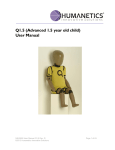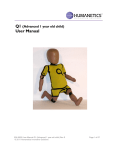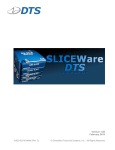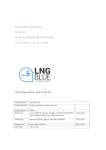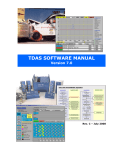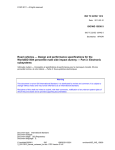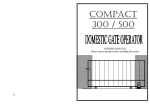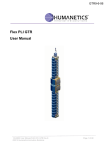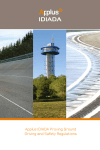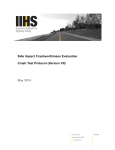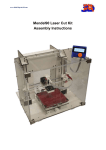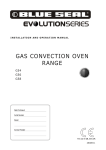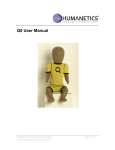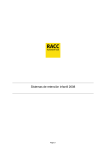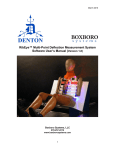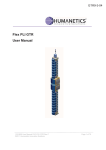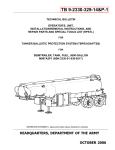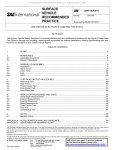Download User Manual
Transcript
Q3 (Advanced 3 year old child) User Manual 020-9905 User Manual Q3 (Advanced 3 year old child) Rev C © 2011 Humanetics Innovative Solutions Page 1 of 65 For information on Humanetics products, please visit our web site at www.humaneticsatd.com or contact: Humanetics Innovative Solutions 47460 Galleon Drive Plymouth, MI 48170, USA Telephone: 734-451-7878 Fax: 734-451-9549 No part of this publication may be reproduced, stored in a retrieval system or transmitted in any form or by any means, electronic, photocopying, recording, mechanical or otherwise, without the express written consent of Humanetics Innovative Solutions. Copyright © 2011 Humanetics Innovative Solutions, All rights reserved. The information in this manual is furnished for informational use only, and is subject to change without notice. Humanetics Innovative Solutions assumes no responsibility or liability for any errors or inaccuracies that may appear in this manual. 020-9905 User Manual Q3 (Advanced 3 year old child) Rev C © 2011 Humanetics Innovative Solutions Page 2 of 65 Contents Contents .......................................................................................................................................... 3 List of Figures .................................................................................................................................. 5 1. Introduction............................................................................................................................. 6 2. General Description and Features ........................................................................................ 7 2.1 Design History ..................................................................................................................................................................... 7 2.2 Application ............................................................................................................................................................................ 7 2.3 Features ................................................................................................................................................................................. 7 2.4 Instrumentation Options ................................................................................................................................................... 9 2.5 Main Dimensions ................................................................................................................................................................ 9 2.6 Mass Distribution ................................................................................................................................................................ 9 2.7 Standard Dummy ............................................................................................................................................................ 10 3. Instrumentation .................................................................................................................... 11 3.1 General ............................................................................................................................................................................... 11 3.2 Transducers ....................................................................................................................................................................... 11 3.3 Accelerometer Mounts ................................................................................................................................................... 12 3.4 Angular Velocity Sensor Mounting .............................................................................................................................. 14 3.5 Cable routing and protection ........................................................................................................................................ 14 4. Assembly - Disassembly ....................................................................................................... 15 4.1 General Overview ............................................................................................................................................................. 15 4.2 Head .................................................................................................................................................................................... 15 4.3 Neck .................................................................................................................................................................................... 17 4.4 Torso .................................................................................................................................................................................... 20 4.5 Lumbar Spine and Abdomen ........................................................................................................................................ 28 4.6 Pelvis .................................................................................................................................................................................... 31 4.7 Legs ...................................................................................................................................................................................... 32 4.8 Arms .................................................................................................................................................................................... 34 4.9 Abdomen ............................................................................................................................................................................ 36 4.10 Suit ....................................................................................................................................................................................... 36 5. Pre-test Checks ..................................................................................................................... 37 020-9905 User Manual Q3 (Advanced 3 year old child) Rev C © 2011 Humanetics Innovative Solutions Page 3 of 65 5.1 Inspection ........................................................................................................................................................................... 37 5.2 Click Stops and Arm adjustment ................................................................................................................................. 39 5.3 Time Interval between Tests ........................................................................................................................................ 39 6. Dummy Parts List and Recommended Spare Parts ......................................................... 40 6.1 Dummy Parts List ............................................................................................................................................................ 40 6.2 Recommended Spare Parts........................................................................................................................................... 43 7 . Certification Equipment....................................................................................................... 44 8. 9. 7.1 Requirements .................................................................................................................................................................... 44 7.2 Equipment.......................................................................................................................................................................... 44 7.3 Equipment Parts List ....................................................................................................................................................... 49 Certification Tests ............................................................................................................... 50 8.1 Head Certification ........................................................................................................................................................... 50 8.2 Certification of the Neck ............................................................................................................................................... 52 8.3 Certification of the Lumbar Spine ............................................................................................................................... 56 8.4 Certification of the Abdomen ....................................................................................................................................... 61 8.5 Certification of the Thorax ............................................................................................................................................ 62 References ............................................................................................................................. 64 020-9905 User Manual Q3 (Advanced 3 year old child) Rev C © 2011 Humanetics Innovative Solutions Page 4 of 65 List of Figures Figure 1. Q-dummy family (from left to right: Q1.5, Q3, Q0, Q6 and Q1) ..........................................................6 Figure 2. Accelerometer mounts for Q3 ........................................................................................................13 Figure 3. ATA ARS-01 (left) and ARS-06 (flanged version) (right).....................................................................14 Figure 4. DTS ARS’s on the special mount (IT-900) ........................................................................................14 Figure 5. Q3 Head Assembly including instrumentation ...................................................................................16 Figure 6. Q3 Dummy Neck Assembly ............................................................................................................18 Figure 7. Q3 Dummy Head – Neck Assembly ................................................................................................20 Figure 8. Q3 Thorax Assembly (Part of torso assembly 020-4400)...................................................................22 Figure 9. Q3 Dummy Shoulder Swivel Assembly (020-3000) ...........................................................................24 Figure 10. IR-TRACC attachment hardware (spine side) ...............................................................................26 Figure 11. IR-TRACC attachment hardware (rib cage side) ...........................................................................27 Figure 12. Q3 side impact IR-TRACC arrangement (optional).......................................................................28 Figure 13. Tighten nut down on the lumbar .................................................................................................29 Figure 14. Q3 Dummy Abdomen, Lumbar Spine and Pelvis (parts of 020-4000) ............. Error! Bookmark not defined. Figure 15: Arm Assemblies .........................................................................................................................35 Figure 16. Arm Assemblies .........................................................................................................................35 Figure 17. Q-series neck and lumbar spine head form test set-up for frontal test ...........................................45 Figure 18. Q-series neck and lumbar spine head form test set-up for lateral test ............................................45 Figure 19. Head form .................................................................................................................................46 Figure 20. Q3 full-body impactor (accelerometer not shown) .......................................................................48 Figure 21. Full body pendulum impactor suspension wire diagram .................................................................49 Figure 22. Frontal Head drop certification set-up .........................................................................................51 Figure 23. Lateral Impact Head certification set-up - rear view of head. .........................................................52 Figure 24. Q3 neck certification test set-up for frontal test ...........................................................................54 Figure 25. Q3 neck certification test set-up for lateral test ...........................................................................55 Figure 26. Q3 lumbar spine certification test set-up for frontal test ...............................................................58 Figure 27. Q3 lumbar spine certification test set-up for lateral test ...............................................................60 Figure 28. Abdomen certification test set-up ...............................................................................................61 020-9905 User Manual Q3 (Advanced 3 year old child) Rev C © 2011 Humanetics Innovative Solutions Page 5 of 65 1. Introduction In the late 1970s and early 1980s, TNO and others developed the P-dummies, a series of child dummies that covers almost the complete child population up to 12 years. The P-series dummies are still test tools for the European regulation ECE-R44 and are also adopted by many other standards. In 1993 the International Child Dummy Working Group started the development of a new series of child dummies as a successor to the P-series. This new series was called the Q-series. As of September 2004 the series is available in four age groups, representing a Newborn, 1 year, 1½ year, 3 year and 6 year old child. In 2004 a major update of the Q-dummy series was performed, resulting in the completion of the series from Q0 through Q6. The Q1.5 dummy and the Q0 were added to the series, and modifications were made to enhance durability and measurement capabilities. Part of the development of the Q-dummies has taken place within the European Research programs CREST [1], and CHILD [2], both aimed at improving child safety in cars. FTSS reserves the right to make improvements or implement changes to the dummy, the certification or the user manual if this is deemed necessary. We will of course inform our customers of any changes or modifications as they occur. Figure 1. Q-dummy family (from left to right: Q1.5, Q3, Q0, Q6 and Q1) 020-9905 User Manual Q3 (Advanced 3 year old child) Rev C © 2011 Humanetics Innovative Solutions Page 6 of 65 2. General Description and Features 2.1 Design History The development of the Q-series, directed by the International Child Dummy Working Group, resulted in a Q3 dummy in 1998, followed by the addition of the Q6 dummy in 1999, and the Q1 in 2000. Based on customer feedback and test results, FTSS has received comments on the dummies’ performance and durability. This has resulted in an update program that was started in 2004. This update was aimed at a number of issues with the Q dummies in the shoulder, and head/neck area. During this period the Q0 and Q1.5 were added to the family, based on Q-series anthropometry and biofidelity data. The European Enhanced Vehicle-safety Committee performed an extensive evaluation program of the Qseries in 2004. A full report on a possible recommendation for use of the dummies in ECE R44 tests is expected in 2005. Results of the first evaluations have been published at the 19th Enhanced Safety of Vehicles conference in 2005 [3]. In 2006 the New Programme for the Assessment of Child-restraint Systems (NPACS) adopted the Q dummies for their test protocols. 2.2 Application The Q6 dummy is suitable for frontal as well as side impact CRS evaluations, to be used for both homologation, consumer rating and research purposes. Possible applications include: Child Restraint Systems (CRS) testing. This includes the European ECE R44 and the US FMVSS 213 regulations. The Q-dummies have been designed to succeed the P-dummies in CRS evaluation regulations. EuroNCAP tests. The dummy has been designed to withstand impact with closing velocities up to an average EuroNCAP level. NPACS tests. The New Programme for the Assessment of Child-restraint Systems (NPACS) protocols calls for the Q series for their frontal and side impact consumer test procedures for CRS performance rating [4]. Out-of-position tests (OOP), including airbag interaction. ISO-side impact procedure. 2.3 Features The Q-dummies have improved biofidelity over the P-series. Biomechanical information from children and scaled adult biomechanical response curves has been used to define the dummy response. The anthropometry of the dummy is based on CANDAT data. The dummies can be equipped with accelerometers, angular velocity sensors, load cells and displacement sensors. This allows evaluation of the injury risk under various circumstances. Special attention has been paid to the handling characteristics of the dummy, ensuring the dummy can be assembled and disassembled quickly, and installing the dummy in the test configuration is simple and repeatable. 020-9905 User Manual Q3 (Advanced 3 year old child) Rev C © 2011 Humanetics Innovative Solutions Page 7 of 65 The influence of transducers upon the kinematics of the dummy is minimized, and protection of transducers and cables is integrated in the dummy design. Head The head is largely made from synthetics. The head cavity is large enough to allow use of several instruments, including linear accelerometers and angular velocity sensors. Neck The neck is flexible and allows shear and bending in all directions. The segmented design allows a realistic rotational behavior. The neck is equipped with low stretch neck-cord in order to prevent excessive elongation. The neck-cord is also designed to act as a safety cord in case of rubber failure. A six channel load cell can be mounted at the neck-head and neck-torso interface. Thorax The thorax of the child is represented by a single rib-cage. The deformation can be measured with an IRTRACC sensor. The shoulders are connected with a flexible joint to the thorax, allowing deformation forwards. Accelerometers can be mounted on the spine to measure linear accelerations. Abdomen The abdomen is foam covered with skin. Biomechanical data from children has been used to determine the required stiffness. Lumbar Spine The lumbar spine is a flexible rubber column, which allows shear and bending in all directions. A six channel load cell can be mounted between the lumbar spine and the pelvis. Pelvis The Q-dummy pelvis has removable hip joints. An accelerometer array can be mounted in the pelvis. Special hip joints are available that allow to position the dummy in a standing position. Legs The knee joints can be locked in any position. This feature can be used to facilitate positioning the dummy in a standing position. Note that the dummy does not have the ability to stand without support. It must be placed against some object, such as the dashboard. 020-9905 User Manual Q3 (Advanced 3 year old child) Rev C © 2011 Humanetics Innovative Solutions Page 8 of 65 2.4 Instrumentation Options The complete list of instrumentation options includes 31 channels: Head Head Upper Neck Upper Neck Thoracic Spine Thorax Lower Lumbar Spine Pelvic 2.5 Ax, Ay, Az linear acceleration. Wx, Wy, Wz angular velocity. Fx, Fy, Fz forces and Mx, My, Mz moments. Fx, Fy, Fz forces and Mx, My, Mz moments. Ax, Ay, Az linear acceleration. 'ribcage' Dx or Dy deflection. Fx, Fy, Fz forces and Mx, My, Mz moments. Ax, Ay, Az linear acceleration. Main Dimensions The main dimensions of the Q-dummy series are described below. Note that dimensions have been based on a limited number of dummies, and are subject to change. Description * Seating height (head tilted forward) Shoulder height (sitting) Stature Chest depth** Shoulder width (maximum) Hip width Back of buttocks to front knee Back of buttocks to popliteus, sitting Q3 Dimension [mm] Tolerance ± [mm] 544 329 985 146 259 200 305 253 9 7 9 5 9 7 9 9 *) Measurements are valid for the dummy without suit. **) Chest depth is measured at the centre line of the fixation hole for the displacement transducer. 2.6 Mass Distribution The table below shows the masses of the various components of the dummy. The masses given include accelerometer mounts, the IR-TRACC and all screws and fixings. Component Head + Neck (incl. acc. mount) Torso (incl. acc. Mounts & IR-TRACC) Legs (left & right) Arms (left & right) Suit Total 020-9905 User Manual Q3 (Advanced 3 year old child) Rev C © 2011 Humanetics Innovative Solutions Q3 Mass [kg] Tolerance [kg] 3.17 5.80 3.54 1.48 0.40 14.40 ± 0.10 ± 0.30 ± 0.10 ± 0.10 ± 0.10 ± 0.40 Page 9 of 65 2.7 Standard Dummy The standard Q-dummy is delivered with the following items: - One piece of clothing (a yellow suit); - Structural replacements in the location of the load cells; - One set of mounting blocks for use with uni-axial accelerometers. 020-9905 User Manual Q3 (Advanced 3 year old child) Rev C © 2011 Humanetics Innovative Solutions Page 10 of 65 3. Instrumentation 3.1 General The dummy accepts both accelerometers and load cells as standard instrumentation. Angular velocity sensors (DTS-ARS and Applied Technologies Associates type ARS-01 or ARS-06 (flanged version)) can be fitted to the head; this requires an alternative head accelerometer mount. The dummy can be equipped with uni-axial accelerometers for all locations. Tri-axial accelerometers can be used on the pelvis and thorax location. The standard dummy will be delivered including mounting blocks for uni-axial accelerometers. The load cells or its structural replacements are a part of the dummy structure; the structural replacements have to be used in absence of the actual transducer. A 6-channel load cell (FTSS model IF217 or IF-218) can be placed in the upper neck, lower neck and lumbar spine location. 3.2 Transducers The Q3 dummy can be fitted to measure any or all of the following parameters (see also notes below): Head Standard Optional - 3 uni-axial accelerometers in head (Ax, Ay, Az) - 3 angular velocity sensors: Applied Technologies Associates type ARS-01 or ARS-06 (flanged version) or DTS-ARS. Neck Standard - Upper neck 6 channel load cell, 3 forces, 3 moments (Fx, Fy, Fz, Mx, My, Mz). FTSS Model IF-217 (350 Ohm) or IF-218 (120 Ohm). - Lower neck 6 channel load cell, 3 forces, 3 moments (Fx, Fy, Fz, Mx, My, Mz). FTSS Model IF-217 (350 Ohm) or IF-218 (120 Ohm). Thorax Standard Optional - 3 uni-axial accelerometers (or tri-axial accelerometer) in upper spine (Ax, Ay, Az). - 1 IR-TRACC sensor to measure chest deformation, frontal or lateral (Dx or Dy) FTSS model IF-362. - Additional accelerometers may be installed with double sided tape on the thoracic spine (Ax, Ay) (see notes below). Lumbar Spine Standard - 6 channel load cell at lumbar spine/ pelvis interface (Fx, Fy, Fz, Mx, My, Mz). FTSS Model IF-217 (350 Ohm) or IF-218 (120 Ohm). Pelvis Standard - 3 uni-axial accelerometers (or tri-axial accelerometer) on pelvis skeletal structure (Ax, Ay, Az). 020-9905 User Manual Q3 (Advanced 3 year old child) Rev C © 2011 Humanetics Innovative Solutions Page 11 of 65 Notes: 1. IR-TRACC sensor may be mounted in two ways, either to measure frontal or lateral deformations. The IR-TRACC sensor cannot record the true deformation in oblique impacts. It is recommended not be use the IR-TRACC in tests with expected high oblique rib deformations; this can cause damage to the IRTRACC sensor, as it has limited range of motion in directions perpendicular to its sensitive deflection direction. 2. Information on the installation of the instrumentation can be found in the assembly/disassembly section of this manual. 3. The Upper Neck Load Cell does not require any correction for measurement of the moment around the OC joint. The (theoretical) OC joint coincides with the neutral axis of the moment measurement of the (FTSS) load cell. 4. Additional accelerometers may be mounted in the dummy for extra/redundant information. There are no fixed points for attaching these accelerometers. Instead, double-sided tape may be used to attach the accelerometer to the desired location. Two accelerometers may be used to measure deformation velocity and the deformation itself. The procedure is as follows: Install the accelerometers in the dummy. The sensitive axes of the transducers should be aligned as good as possible. Furthermore, the accelerometers should be installed in locations that are expected to retain their alignment during the deformation phase. Make sure that the accelerometers are not located on positions that may contact other parts of the dummy as a result of deformation. To process and combine the data first filter both signals at CFC1000 according to SAE J211. Subtract the signals and integrate the result. This results in the deformation velocity. Numerical integration of this signal gives the deformation itself. Note that this method gives an approximation of the actual deformation. The accuracy is limited due to the fact that the accelerometers do not remain properly aligned during the test and the numerical integrations that include the small measurement errors of the accelerometers cumulative in the velocity and displacement result. The longer the time interval is the larger the cumulative error can be. Experience with the Q3 dummy shows that usage of the acceleration integration method results in an under-estimation of the deformation. At 4.3 m/s initial impact velocity the error is approximately 10%. At 6.7 m/s it is approximately 20%. 3.3 Accelerometer Mounts FTSS support three brands/models of accelerometers or equivalent Endevco 7264 and 7267A series Entran EGAS Series and EGE3-73 Tri-axial. Kyowa ASM Series MSC 126M/CM Uni-axial accelerometers Note: The tri-axial accelerometers Endevco 7267A and Entran EGE3-073 can not be fitted to the head. The head will only accept uni-axial accelerometers. Note: Thorax and Pelvis locations will ONLY accept tri-axial transducers with a side-entry cable. 020-9905 User Manual Q3 (Advanced 3 year old child) Rev C © 2011 Humanetics Innovative Solutions Page 12 of 65 The following accelerometers and mounts can be used for the Q3 dummy: Only uni-axial accelerometers: Location Accelerometer Type ENTRAN EGAS-FS-50 KYOWA ASM-200BA ENDEVCO 7264-2000 7264C-2000 ENDEVCO 7264A-2000 7264B-2000 MSC 126M/CM Figure 2. Head Mount (only uni-axial accels) Thorax Pelvis I.AD I.AO I.AO I.AM I.AN I.AN I.AM I.AN I.AN I.AD I.AO I.AO I.AM I.AN I.AN Accelerometer mounts for Q3 Tri-axial: Location Accelerometer Type ENDEVCO 7267A-1500 Tri-axial Head Mount (only uni-axial accels) Thorax Pelvis Not possible Use Endevco Mount base Use Endevco Mount base 020-9905 User Manual Q3 (Advanced 3 year old child) Rev C © 2011 Humanetics Innovative Solutions Page 13 of 65 3.4 Angular Velocity Sensor Mounting The application of angular velocity sensors is possible in the head. There are two options: 1. ATA ARS-01 or ARS-06 (flanged version) (see Figure 3) with special mount block 020-1014. The mount block 020-1014 consists of a base and three ATA ARS sensor blanks of similar weight and size. Any of these ARS sensor blanks can be replaced with an ATA ARS-01 or ARS-06 (flanged version) sensor. The 020-2014 mounting block will accept the same mount block as the standard accelerometer mounting for the head (I.AD or I.AM, see Figure 2). The ATA ARS sensor blanks should not be removed if there are no sensors to replace them. Figure 3. ATA ARS-01 (left) and ARS-06 (flanged version) (right) 2. DTS ARS-12K with special combine accelerometer/ARS mount (FTSS part # IT-900) on the standard bracket 020-1013A. The sensor and the mount are shown in Figure 4. Figure 4. 3.5 DTS ARS’s on the special mount (IT-900) Cable routing and protection The Q3 dummy transducers have been designed and selected for use with small cross-section cables. These cables do not need much space and ensure minimum interference with the kinematics of the dummy. In the design of the Q3 dummy paths for the transducer cables have been defined. The general rule is that all cables should be routed towards the thoracic spine of the dummy. Cables should run from the top to the base of the thoracic spine. At the lumbar spine/thorax interface, the cables go either towards the left or the right side. The abdomen has been formed to allow the routing of the cables in such a way that they lie recessed between the rib cage and the pelvis skin. A cable guide (020-4411) cover is mounted on the back of the thoracic spine. 020-9905 User Manual Q3 (Advanced 3 year old child) Rev C © 2011 Humanetics Innovative Solutions Page 14 of 65 4. Assembly - Disassembly 4.1 General Overview The Q-dummy consists of the following main components: head neck thorax lumbar spine abdomen pelvis arms legs The dummy is dressed in a tight-fitting suit. This suit is an integral part of the dummy and should be worn during all tests. A full description of the instrumentation capabilities is given in section 3. The tools needed for assembly and disassembly of the Q3-dummy are: screwdrivers metric hex keys. 4.2 Head Construction The head assembly consists of the following parts (see also Figure 5.): Description Head Assembly Head front assembly Head rear assembly. Screws BHCS M5 x 12 Load Cell structural replacement Screw FHCS M5 x 10 Accelerometer mounting base (standard) Screw SHCS M3 x 40 Screw SHCS M3 x 10 Part No Qty in Assembly 020-1100 020-1020 020-1025 5000565 020-2007 5000084 020-1013A 5000649 5000119 1 1 1 4 1 4 1 1 2 The head consists of two parts: the front assembly (skull and skin) and a rear assembly (skull cap). The rear assembly may be removed by unscrewing the four M5x12 button head cap screws located at the rear of the head. The head skin and skull are molded together and cannot be separated. Inside the head is a large cavity which may be used to mount various types of instrumentation. The standard arrangement is to have the head mounting block bolted in the head which will accept 3 uni-axial accelerometers. Optionally a bracket for combined accelerometer-angular rate sensor application (020-1014) can be used. 020-9905 User Manual Q3 (Advanced 3 year old child) Rev C © 2011 Humanetics Innovative Solutions Page 15 of 65 5000565 020-1025 020-1014 (optional) 020-1013A (standard) 020-1020 020-2007 (load cell structural replacement) Screws 5000084 Figure 5. Q3 Head Assembly including instrumentation Head instrumentation - both accelerometer bracket arrangements 020-1013 (standard) and 020-1014 (optional ARS version) shown Assembly and Disassembly Disassembly The head is attached to the neck though the load cell or the structural replacement. To disassemble the head, first detach the load cell from the neck. 1. First remove the head rear assembly by unscrewing the four button head cap screws at the back of the head. 2. The accelerometer array can be removed in order to reach the screws in the upper neck load cell (or the load cell replacement). 3. With the accelerometer array removed, the M5 SHCS screws that attach the load cell to the neck can be reached through the top of the head. 4. Remove the head and upper neck load cell or structural replacement from the neck. 5. Turn the head upside down, and remove the FHCS screws at the base of the head. 020-9905 User Manual Q3 (Advanced 3 year old child) Rev C © 2011 Humanetics Innovative Solutions Page 16 of 65 Assembly The head can be assembled to the dummy by reversing the order of the disassembly. Instrumentation Standard Instrumentation 1. To install the accelerometers, first remove the head rear assembly by unscrewing the four M5x12 button head screws. 2. Remove the head accelerometer mounting block (020-1013A), from the head cavity, by unscrewing the three cap head screws. 3. The uni-axial accelerometers must first be mounted onto a mounting block. 4. Bolt the mounting block onto head accelerometer block using the two socket head cap screws supplied with the mount. Mount the interface inside the head front assembly. 5. Replace the head rear assembly and tighten the four bolts. Note: As shown in the head assembly section, it is advised mount the head onto the neck, before placing the accelerometers in the head cavity. To remove the accelerometers, the procedure described above must be performed in the reverse order. Alternative Instrumentation The cavity in a Q3 dummy head is large enough to accept an array of angular velocity sensors, type -01 or ARS-06 (flanged version) (Applied Technologies – ATA Sensors). To mount these sensors, the use of an alternative accelerometer mounting base is required (part No. 020-1014). On the standard head accelerometer mounting base (020-1013A) the application of DTS-ARS sensors is possible. For additional information on the mounting of these sensors see Section 3 and Figure 5. 4.3 Neck Construction The neck assembly consists of the following parts (from top to bottom): Description Neck Assembly Tested and Certified Neck Molded, pre-tested Neck cable assembly. Screws FHCS M3 x 8 Screws BHCS M5 x 0.8 x x12 Part No Qty in Assembly 020-2100 020-2101 020-2200 5000116 5000003 1 1 1 2 4 The main part of the neck assembly consists of a rubber column, with bonded metal interface plates attached to the top and bottom. The neck assembly has four threaded inserts in the top surface which are used to mount the upper neck load cell (FTSS model IF-217 or IF-218) or its structural replacement (020-2007) onto the neck. The upper neck plate has two cut-outs towards the rear to allow proper routing of the upper neck load cell cables. 020-9905 User Manual Q3 (Advanced 3 year old child) Rev C © 2011 Humanetics Innovative Solutions Page 17 of 65 The neck cable assembly contains high yield strength, low stretch synthetic fiber cord. This neck cable assembly is tested and pre-stretched to ensure the correct length and the performance of the neck assembly. The cable assembly should not be disassembled by the user. The neck cable will act as a safety measure in case of rubber failure. 5000116 020-2200 020-2101 5000003 020-2204 (included in 020-2200 assembly) Figure 6. Q3 Dummy Neck Assembly 020-9905 User Manual Q3 (Advanced 3 year old child) Rev C © 2011 Humanetics Innovative Solutions Page 18 of 65 Assembly and Disassembly Disassembly Head & Neck 1. To disassemble the neck, remove the head and upper neck load cell structural replacement as described above. 2. After removing the head assembly and load cell structural replacement, the screws at the base of the neck can be reached and removed. 3. To inspect the neck-cable assembly, remove the two FHCS M3 x 8 at the top of the neck and undo the nut at the bottom of the neck. The Neck-cable assembly can now be pulled out from the top. The neck cable assembly should NOT be disassembled. Note: Do not unscrew the screws at the bottom of the clamping plates on the neck cable assembly. The neck cable is pre-stretched and clamped down at manufacturing, and should not be disassembled. In case of cable damage, customers are recommended to replace the complete neck cable assembly (020-2200). There is no adjustable pretension in the cable. The nut (020-2204) can be tightened firmly. Assembly Head & Neck 1. Perform the steps described under disassembly in reverse order. Instrumentation 1. To install a load cell, first remove the load cell structural replacement. To do so, remove the head as shown above. 2. Remove the four M5 x 10 FHCS screws that attach the load cell to the base of the head assembly. 3. Remove the load cell structural replacement and install the load cell (FTSS type IF-217 or IF-218). The round base plate should be facing up, and the cable exits facing downwards at the rear and the back of the neck. 4. Fasten the load cell to the base of the head using the four M5x10 counter sunk head cap screws. 5. Assemble head and load cell onto the top of the neck using the four M5 x 12 SHCS screws. 6. Mount the head instrumentation in the head and close the head with the skull cap 020-9905 User Manual Q3 (Advanced 3 year old child) Rev C © 2011 Humanetics Innovative Solutions Page 19 of 65 Note: Always mount the upper neck load cell BEFORE the head accelerometers, as the accelerometer array will block the top access to the screws through the head. 5000654 020-1100 + load cell replacement 020-2007 020-2100 5000003 Figure 7. 4.4 Q3 Dummy Head – Neck Assembly Torso Construction The torso consists of a metal thoracic spine, left and right shoulder assemblies, a clavicle and a rib section. The rib cage is made of a deformable synthetic composite. The shoulders are connected with the clavicle element, which attaches to the left and right shoulders, and to the rib cage (sternum). The parts of the Thorax assembly are listed below: 020-9905 User Manual Q3 (Advanced 3 year old child) Rev C © 2011 Humanetics Innovative Solutions Page 20 of 65 Description Thorax (part of torso assembly) Thoracic Spine Load cell Structural replacement Neck / Torso interface plate Screw SHCS M5 x 0.8 x 12 Gimbal Ring Pivot Pin – Gimbal Gimbal Shaft Retaining Ring Shaft Locking Boss Rib Cage Assembly Bracket IR-TRACC Attachment Screw FHCS M4 x 0.7 x 10 Screw BHCS M5 x 0.8 x 16 Shoulder Interface assembly RH Shoulder Interface assembly LH Screw BHCS M4 x 0.7 x 12 Clavicle Screw FHCS M6 x 1.0 x 12 Scapula Molding RH Scapula Molding LH Screw FHCS M5 x 0.8 x 20 Shoulder Swivel assembly Shoulder Swivel Body * Shoulder Retaining Cap * M8 Spring Plunger * Detent Peg * Spring LCM 090F 1 MW * 12mm Internal Circlip * M4x12 BHCS * Screw FHCS M5 x 0.8 x 10 Clavicle Retainer Screw FHCS M5 x 0.8 x 12 Screw SHCS #5-40 x 5/8 Spacer IR-TRACC Attachment Screw SSCP M4 x 0.7 x 5 Cable Guide Screw FHCS M4 x 0.7 x 16 Part No Qty in Assembly (020-4400) 020-4401 020-2007 020-2015 5000002 020-4405 020-4402 020-4403 5000751 020-4404 020-4100 020-4406 5000023 5000416 020-3310 020-3320 5000005 020-3201 5000139 020-3100 020-3101 5000386 020-3000 020-3002 020-3005 5000328 020-7103 5000650 5000651 5000005 5000084 020-4200 5000374 9002975 020-4407 5000406 020-4411 5000447 1 1 1 1 4 1 2 1 2 1 1 1 2 6 1 1 8 1 2 1 1 4 2 2 2 4 2 2 2 8 4 1 1 1 2 1 1 2 *) Items marked are not shown in Figure 8, but in Figure 9. (Shoulder Assembly). 020-9905 User Manual Q3 (Advanced 3 year old child) Rev C © 2011 Humanetics Innovative Solutions Page 21 of 65 5000002 020-2015 020-2007 5000084 020-4411 Screws 5000447 020-4405 020-4402 020-4403 020-4404 Screw 5000406 020-3000 020-3320 (LH) 020-3310 (RH) Screws 5000005 020-3101 (LH) 020-3100 (RH) Screws 5000386 5000139 020-3201 020-4200 Screw 5000374 020-4401 Screws 5000416 020-4100 020-4406 Screw 5000023 9002975 Spacers 020-4407 Figure 8. Q3 Thorax Assembly (Part of torso assembly 020-4400) 020-9905 User Manual Q3 (Advanced 3 year old child) Rev C © 2011 Humanetics Innovative Solutions Page 22 of 65 Assembly and Disassembly Disassembly Upper/Lower Torso 1. The suit should be removed for proper access to the thorax assembly. 2. Remove the cable cover at the back of the thoracic spine (020-4401). 3. The upper part of the body can easily be separated from the lower part of the body by removing the two M6 x 43 countersunk head screws located at the base of the thoracic spine. First loosen the two bottom screws at the base of the rib assembly than unscrew and remove the M6 x 43 counter sunk screws. The upper body can then be lifted from the lower part of the dummy. Note: when operating on the upper torso section of the dummy, for example when installing or removing components or installing instrumentation, it is convenient first to remove the head and neck (see the paragraphs above for the procedure how to do this), and then divide the dummy in two parts by removing the thorax/lumbar spine screws. This gives easy access to the internals of the upper torso and to the various bolts and screws. Note: to prevent unnecessary wear, the rib cage and shoulders should not be removed from the thoracic spine under normal circumstances. Arms 1. The first step is to remove the arms. To do so, turn the dummy sideways. At the back of the scapula are two countersunk M5x20 screws (5000386). Rotate the upper arm around the shoulder lateral axis until the screws become accessible. Remove the first screw, rotate the arm slightly and remove the second screw. Remove the scapula by pulling it towards the back. The arm may now be removed. Repeat this procedure for the other arm. Clavicle 2. The clavicles are attached to the shoulder spine interface (020-3310/020-3320) with a single M6x16 countersunk screw (5000097) on each side. Remove these screws. 3. Remove the M5 x 12 countersunk head screw which is used to mount the clavicle retainer (5000096) and clamp the clavicle to the rib cage. Rib Cage 4. Remove the rib cage by unscrewing the six M5 x 16 button head cap screws, three on each side of the thoracic spine. Shoulders 5. Finally, the shoulder spine interfaces (020-3310 & 020-3320) can be removed by unscrewing the three M4x12 button head cap screws of each shoulder spine interface. 6. The shoulder swivel assembly can be disassembled by removing the 4 M4 button head screws in the shoulder retaining cap. Two holes are provided in the shoulder retaining cap to adjust the click stops in the shoulders, as described in the pre-test checks. 020-9905 User Manual Q3 (Advanced 3 year old child) Rev C © 2011 Humanetics Innovative Solutions Page 23 of 65 Assembly To assemble the thorax, perform the operation described above in reverse order. Note: The shoulder 1-2 g friction setting is not required as the arm is kept in position by the click-stops. 5000561 5000650 020-7103 020-3002 5000328 020-3005 5000005 Figure 9. Q3 Dummy Shoulder Swivel Assembly (020-3000) Instrumentation Standard Instrumentation Accelerometers The thorax can be equipped with three uni-axial accelerometers or a tri-axial accelerometer in the cavity located at the back and top of the thoracic spine. 1. The uni-axial accelerometer must first be mounted onto the specified mounting block. The tri-axial accelerometer should be mounted using a mounting base (Endevco type 23898). 2. Use two SHCS M3 x 10 screws to attach the mounting block inside the cavity. The longest side of the mounting base should be facing upwards. Load cell 1. To use the lower neck load cell (IF-217 or IF-218), remove the load cell structural replacement (0202007). If the neck is installed, remove this first (four M5 x 10 button head cap screws). 2. Note that there is a Neck torso interface plate (020-2015) between the load cell structural replacement (020-2015) and the neck. Remove the load cell structural replacement and the neck torso interface plate together by unscrewing the four M5 x 12 socket head cap screws. 3. Remove the neck torso interface plate (020-2015) from the load cell structural replacement by unscrewing the four M5 x 10 countersunk screws. 4. Install the load cell by reversing the procedure described above. First, attach the neck torso interface plate (020-2015) to the load cell with the four countersunk screws. 020-9905 User Manual Q3 (Advanced 3 year old child) Rev C © 2011 Humanetics Innovative Solutions Page 24 of 65 5. Place the load cell on top of the thoracic spine (020-4401). The base plate should be facing upward, and the cable exits should be at the rear, cables leading downward. Fasten the load cell with the four socket head cap screws. 6. Finally, assemble the neck back on the torso. IR-TRACC The thorax rib cage is equipped with an IR-TRACC displacement sensor that fits into the cavity of the thoracic spine directly below the cavity for the accelerometers. The IR-TRACC attachment hardware consists of: Description Pivot Pin - Gimbal Gimbal Shaft E-clip Shaft Locking Boss Gimbal Ring Screw SSCP M5 x 5 Attachment IR-TRACC Spacer IR-TRACC Attachment Screw SHCS #5-40 x 5/8 Screw FHCS M4 x 0.7 x 10 Part No Qty in Assembly 020-4402 020-4403 5000751 020-4404 020-4405 5000406 020-4406 020-4407 9002975 5000023 2 1 2 1 1 1 1 2 1 2 020-9905 User Manual Q3 (Advanced 3 year old child) Rev C © 2011 Humanetics Innovative Solutions Page 25 of 65 020-4403 5000751 (E-clips not shown) 5000406 020-4404 020-4402 020-4405 Tighten set screw on flat part of pin, after pin is centred Figure 10. IR-TRACC attachment hardware (spine side) Frontal Impacts 1. To use the IR-TRACC (IF-362) for frontal impacts, the IR-TRACC should first be equipped with its attachment hardware. 2. First place the holding boss (020-4404) onto the back of the IR-TRACC and unscrew the set screw. 3. Then hold the gimbal ring (020-4405) at the end of the IR-TRACC and slide the gimbal shaft (0204403) through the holes in the gimbal ring and the hole in the back of the IR-TRACC. 4. Now centre the gimbal shaft and tighten the set screw. 5. The two gimbal pivot pins can be inserted into the thoracic spine. Screw in until they will just appear on the inside of the thoracic spine. 6. Hold the gimbal ring before the pin and screw in further until it holds. 7. Attach the hardware at the other side of the IR-TRACC as shown in Figure 11. Insert M5 screw in the rib cage hole and screw attachment to the rib cage assembly. 020-9905 User Manual Q3 (Advanced 3 year old child) Rev C © 2011 Humanetics Innovative Solutions Page 26 of 65 Figure 11. IR-TRACC attachment hardware (rib cage side) Side Impacts The IF-362 IR-TRACC can also be mounted in side impact orientation. The bracket shown below is mounted onto the inside of the rib-cage, using the rib-attachment holes. These parts are included in Q3 side impact kit (020-Side-Kit) but not included in the standard dummy. The side impact IR-TRACC mounting bracket assembly consists of: Item 1 2 3 4 5 6 7 8 Description Bracket 1, IR-TRACC, side impact. Bracket 2, IR-TRACC side impact Cone spacer Screw SHSS 1/8 x ½ Rod end mount base Screw SHCS M2 x 6 Screw SHCS M5 x 20 Screw SHCS M5 x 12 020-9905 User Manual Q3 (Advanced 3 year old child) Rev C © 2011 Humanetics Innovative Solutions Part No 020-4505 020-4502 020-4507 9002949 3620-44 5000082 5000371 5000002 Qty in Assembly 1 1 2 1 1 1 2 2 Page 27 of 65 Figure 12. Q3 side impact IR-TRACC arrangement (optional) 1. To use the IR-TRACC (IF-362) for side impacts the IR-TRACC should first be equipped with its attachment hardware as shown in Figure 12. 2. First mount the rod end mount base in the end of the IR-TRACC and secure it with the M2 screw (item 6). 3. Attach the brackets (item 1 and 2) to each other using the M5 x 12 screws. 4. Connect the IR-TRACC rod end to the bracket using the shoulder screw (item 4) and cone spacers (item 3). 5. Attach the rib attachment hardware to the top end of the IR-TRACC. 6. Remove two of the M5 button head rib cage attachment screws on the far side of the chosen impact side. 7. Mount the bracket with IR-TRACC on the side of the rib-cage, with the two M5 x 20 screws and attach the top end to the rib cage with two M4 counter sink screw. 4.5 Lumbar Spine and Abdomen Construction The lumbar spine assembly consists of a rubber column with metal interfaces bonded to the top and bottom. The top interface is U-shaped (vertical elements at the front and back). The thoracic spine fits into this bracket and is secured using the two M6 x 43 screws. At the bottom side, four M5 x 12 cap head screws are used to attach the lumbar spine assembly to either the model IF-217 load cell or the load cell structural replacement (020-2007). The lumbar spine assembly has a cable fitted through the centre. This is used to pre-tension the spine to achieve the correct dynamic properties, and as a security measure (protection in case of lumbar spine damage or failure). 020-9905 User Manual Q3 (Advanced 3 year old child) Rev C © 2011 Humanetics Innovative Solutions Page 28 of 65 The abdomen is full foam part covered by a plastic skin. The parts of the lumbar spine and abdomen are listed below (see also Figure 13.) Description Part No Qty in Assembly Lumbar Spine Assembly (tested and certified) Lumbar Spine central molding, pre-tested Lumbar Cable M6 nut (self locking) M6 Plain Washer Load cell structural replacement Screw SHCS M5 x 12 Screw FHCS M5 x 10 Abdomen foam part 020-6000 020-6001 020-6100 5000093 5000094 020-2007 5000002 5000084 020-5000 1 1 1 1 1 1 4 4 1 Assembly and Disassembly Disassembly 1. Remove the upper torso by removing the two M6 x 43 screws at the thoracic spine/lumbar spine interface. 2. Remove the abdomen from the lower torso 3. Remove the four M5 x 12 countersunk head screws, which are used to fasten the load cell (or structural replacement) to the pelvis. 4. Remove the load cell (or load cell structural replacement) from the lumbar spine by removing the four M5 x 12 socket head cap screws. The cable assembly should not need to be removed under normal circumstances. If it becomes necessary, use a screwdriver in the slot at the top of the cable to prevent the cable from turning, and unscrew the self-locking nut with a wrench. In the steel cable there is no pretension required the nut should be tightened up until the play between the cable and neck is eliminated. Figure 13. Tighten nut down on the lumbar 020-9905 User Manual Q3 (Advanced 3 year old child) Rev C © 2011 Humanetics Innovative Solutions Page 29 of 65 Assembly Perform steps 1 to 4 under "disassembly" in reverse order. 020-5000 020-9902 020-6000 020-6001 020-6100 5000093 5000094 (mold) (cable) (nut) (washer) 5000084 020-2007 5000002 020-7011 020-7110 (RH) 020-7100 (LH) 020-7010 5000002 020-7102 LH (020-7112 RH) 020-7101 LH (020-7111 RH) 020-7103 5000650 020-7104 5000098 5000410 Figure 14. Q3 Dummy Abdomen, Lumbar Spine and Pelvis (parts of 020-4000) 020-9905 User Manual Q3 (Advanced 3 year old child) Rev C © 2011 Humanetics Innovative Solutions Page 30 of 65 Instrumentation Load Cell An FTSS IF-217 or IF-218 6-Axis Load cell may be mounted between the lumbar spine and pelvis. 1. To do so, first remove the upper torso from the lumbar spine by removing the two M6x43 screws. 2. Then unscrew the four M5x12 counter-sunk head screws attaching the structural replacement to the pelvis. Remove the lumbar spine/structural replacement assembly from the pelvis casting. 3. Unscrew the four M5x12 screws to remove the structural replacement from the lumbar spine. 4. Attach the load cell to the lumbar spine using four M5 x 12 SHCS. 5. Mount the assembly onto the pelvis casting using four M5x12 counter sunk screws. 4.6 Pelvis Construction The pelvis casting is a single metal casting which fits into the pelvis flesh. The two items are completely separable. The upper legs, with the ball and socket hip joint assemblies, fit into the two openings at the left and right side of the pelvis. The parts of the pelvis are listed below (see also Figure 13.) Description Pelvis assembly Pelvis casting machined Pelvis Flesh Hip joint assembly Left (breakdown see below) Hip joint assembly Right (breakdown see below) Screw SHCS M5 x 12 Breakdown of Hip Joint Assembly Hip Joint Lower L or R Hip Joint Upper L or R Detent Peg Spring Retainer Plate Spring Screw BHCS M3 x 8 Screw FHCS M3 x 6 Part No Qty in Assembly 020-7011 020-7001 020-7010 020-7100 1 1 1 1 020-7110 1 5000002 4 Left (020-7100) Right (020-7110) 020-7101 020-7111 020-7102 020-7112 020-7103 020-7104 5000650 5000653 5000098 020-9905 User Manual Q3 (Advanced 3 year old child) Rev C © 2011 Humanetics Innovative Solutions Qty in each Assembly 1 1 1 1 1 2 2 Page 31 of 65 Assembly and Disassembly Disassembly 1. If necessary, remove the dummy’s upper part, by removing the M6x43 bolts (020-9902) at the lumbar spine thorax interface. 2. Remove the lumbar spine and load cell (or load cell structural replacement) as described in section 4.5. Legs 3. Remove the left and right legs. To do so, put the dummy on its back or chest, and remove the two M5x12 screws in the crotch area (left and right - four screws total). These screws are used to retain the hip joint assemblies. 4. With the screws removed from the dummy, the legs can be removed from the pelvis by pulling them laterally outwards. 5. Hip joint assemblies can be removed from the legs through separation of the upper and lower hip joint. Do so by removal of the two button head M3 screws (see Figure 13). Note: It is not possible to change the friction setting of the hip-joints. The legs are fully supported and positioned by the child restraint system. Skin 6. When the legs are removed, the pelvis flesh can be removed from the pelvis casting by pulling it downwards. Instrumentation Accelerometers The pelvis can be equipped with a mounting block accepting three uni-axial accelerometers or a single triaxial accelerometer. In order to use accelerometers in the pelvis, first mount them onto the mounting block, the tri-axial accelerometer should be mounted on a mounting plate. Then remove the pelvis flesh as outlined in the paragraph above (assembly and disassembly). The mounting block should be attached at the inferior surface at the bottom of the pelvis casting, with the long side of the base plate facing backwards. The cables should be routed forwards when replacing the pelvis flesh. 4.7 Legs Construction The legs consist of an upper leg and lower leg connected to each other with a knee joint. At the hip side, a ball and socket joint is used. This joint should not be taken apart under normal operating circumstances. In the knee joint, a limited range of motion has been built in. At the end of this range, rubber stops are used to smoothly decelerate the motion and thereby preventing spikes on the measurement signals. 020-9905 User Manual Q3 (Advanced 3 year old child) Rev C © 2011 Humanetics Innovative Solutions Page 32 of 65 Description Part No Left Leg assembly L or R Upper Leg Assembly L or R Lower Leg Assembly L or R Shoulder Screw SHSS M5-20 Stop Screw 020-9100 020-9101 020-9102 Part No Right 020-9200 020-9201 020-9202 5000626 020-9901 Qty in each Assembly 1 1 1 1 1 020-9101 020-9201 5000626 020-9901 020-9102 020-9202 Figure 14. Leg Assemblies Assembly and Disassembly Disassembly It is not advised to disassemble the legs, except to replace broken parts. To separate the lower from the upper leg: 1. Remove the motion stop screw (020-9901) located on the inside of the knee joint. 2. Remove the M5x20 socket head shoulder screw (5000626) connecting the two parts of the leg. 020-9905 User Manual Q3 (Advanced 3 year old child) Rev C © 2011 Humanetics Innovative Solutions Page 33 of 65 Assembly 1. Check that the rubber end stops are in the correct position inside the upper knee joint before assembly of the lower leg. 2. Align upper and lower leg at shoulder screw holes and screw in shoulder screw. 3. Before inserting the motion stop screw, place upper and lower leg in a 90º angle with respect to each other. 4. Turn the motion stop screw into the leg as far as it will go. Then turn it back half a turn and check that the motion of the lower leg is without significant friction. Note: It is not possible to change the friction setting of the knee joint in the legs. The legs are fully supported and positioned by the child restraint system. Instrumentation No instrumentation is used in the legs. 4.8 Arms Construction The arms consist of an upper and lower section, connected at the elbow with a joint. At the upper end, a shoulder joint allows a number of degrees of freedom. The main joint is of the ball-and socket type, with a limited range of motion. The upper arm can rotate around its vertical axis. Furthermore, the entire arm can rotate around the shoulder lateral axis. At the elbow joint, the range of motion is limited. At the end of the range of motion, rubber stops in the joint ensure a smooth arrest of motion. This prevents hard contact and reduces spikes on measurement signals. The parts of the arms are listed below Description Arm assembly L or R Upper Arm Assembly L or R Lower Arm Assembly L or R Arm Shoulder shield Shoulder Screw SHSS M5-20 Stop Screw Click Stop Part No. Left Part No. Right 020-9300 020-9400 020-9301 020-9401 020-9302 020-9402 020-9305 020-9909 020-9901 5000328 020-9905 User Manual Q3 (Advanced 3 year old child) Rev C © 2011 Humanetics Innovative Solutions Qty in each Assembly 1 1 1 1 1 1 1 Page 34 of 65 020-9305 020-9301 020-9401 5000328 020-9901 020-9909 020-9302 020-9402 Figure 15. Arm Assemblies Assembly and Disassembly Disassembly The arm should not need (dis-)assembly under normal circumstances. If the arm needs to be removed from the dummy, then follow the procedures described in section 4.4. 1. Remove the upper arm at the clavicle/scapula section. 2. Remove the spring plunger (5000328) and motion stop screw (020-9901). 3. Remove the shoulder screw connecting upper and lower parts of the arm Assembly 1. Perform steps 1-3 under assembly in reverse order. 2. Check that the rubber end stops are in the correct position inside the elbow joint before assembly of the lower arm. 3. Align upper and lower arm at the shoulder screw hole and screw in shoulder screw. 4. Place upper and lower arm under a 90º angle with respect to each other. 5. Turn the motion stop screw into the arm as far as it will go. Then turn back half a turn and check that the motion of the lower arm is without significant friction. The correct position for motion stop screw is the inside of the arm. 6. Screw in the spring plunger in the hole next to the shoulder screw at the outside of the arm. 7. Check the correct settings for the spring plungers (see chapter 5). Do not over tighten the spring plunger. 020-9905 User Manual Q3 (Advanced 3 year old child) Rev C © 2011 Humanetics Innovative Solutions Page 35 of 65 Note: It is not possible to change the friction setting of the elbow joint. The positioning is done by means of the fixed “click stop” positions in the joint. Instrumentation No instrumentation is used in the arms. 4.9 Abdomen Construction The abdomen (020-5000) consists of one part, skinned foam, which is inserted between the pelvis and rib cage. It allows significant deformation of the dummy in the abdominal area. (see Figure 13). Assembly and Disassembly Disassembly To properly remove the abdomen from the dummy you need to perform the following steps: 1. Remove the upper part of the dummy from the lower part (see procedure under lumbar spine and/or thorax paragraphs), by removing the two M6x43 screws from the lumbar spine thorax interface. 2. The abdomen can then easily be taken from the dummy. Note: It is not advised to remove the abdomen from the assembled dummy, as this places forces and strains upon the material, which can in time result in wear and tear. Removing the abdomen as outlined in this paragraph enhances the durability of the abdomen. Assembly 1. The dummy should be divided into the upper and lower half by unscrewing the two M6x43 screws at the lumbar spine. 2. Insert the abdomen into the pelvis. 3. Put the top of the dummy (thorax and head) back on the lumbar spine with the two M6x43 screws at the lumbar spine. Instrumentation No instrumentation is used in the abdomen. 4.10 Suit The dummy is dressed in a tight-fitting neoprene suit (part no. 020-8000). This suit is an integral part of the dummy and should be worn during all tests. To put the suit on, first put on the lower half, legs first, and pull the pants section well into the crotch of the dummy. Then put the arms through the sleeves of the suit and pull it upwards. Close the suit at the back using the hook and loop fasteners (Velcro). The dummy does not wear shoes. 020-9905 User Manual Q3 (Advanced 3 year old child) Rev C © 2011 Humanetics Innovative Solutions Page 36 of 65 5. Pre-test Checks 5.1 Inspection Before performing a test, a visual inspection of the dummy should be made. Special attention should be paid to the following items. Neck The rubber-molded part of the neck should not be damaged, that is: it should be complete and not show any tear and wear. By bending the neck slightly small cracks can also be detected. The neck cable should be checked carefully to check that there is no visible damage to the cord. Shoulders Periodically examine the shoulder to spine interface for damage. Clavicle Inspect the clavicle for cracks in the material. Rib Cage Check the rib cage for tears and cracks in the material. Deform the rib by hand, as this will show cracks if present. Cracks can be hidden by PVC skin that covers the outside of the rib cage. To find significant damage, pay special attention to the rib cage edges. Lumbar Spine The lumbar spine rubber should not be damaged. Inspect the rubber molding for tears and cracks. Replace if the spine is damaged. The cable must be inserted and the nut at the top properly screwed on. There is no pretension required, the nut should be tightened up to the play is eliminated. Abdomen The abdomen should be checked periodically (10 tests) for tearing of the PVC skin. Note that the wear of the abdomen is reduced by observing the proper installation procedure. First remove the upper torso. The abdomen can then be removed by simply lifting it out of the pelvis. Arms Check the friction setting of the shoulder-arm regularly. Check the spring plungers in the elbows. See paragraph 5.2 for instructions. Cable Routing Always provide sufficient slack in the cables to allow the dummy to deform without putting any strain on the cables. This is especially important for the instrumentation located in the head (accelerometers, load cell). Please note that the slack can cause the cables to snag behind some other object in the test set-up, which can result in damage of the head instrumentation. Dummy Certification Besides the inspections to be performed before each test as described above, the dummy should be regularly certified to check its performance. It is advised to certify the dummy regularly as described in chapter 8. 020-9905 User Manual Q3 (Advanced 3 year old child) Rev C © 2011 Humanetics Innovative Solutions Page 37 of 65 020-9905 User Manual Q3 (Advanced 3 year old child) Rev C © 2011 Humanetics Innovative Solutions Page 38 of 65 5.2 Click Stops and Arm adjustment Shoulder The upper arms can be put in two stable positions. The first is vertically along the body, the second one 20 degrees forward from the vertical. Again, the arms should be able to rotate freely until they reach the click-stop position. The force exerted should be sufficient to resist the torques generated by the mass of the arm upon the shoulder joint. The joints will be adjusted in new dummies supplied by FTSS. In case they need to be readjusted proceed as follows: 1. Remove the dummy suit. 2. Remove the shoulder-retaining cap by removing the four M4x12 button head screws. The arm can now be taken from the joint. 3. In the aluminum ring, two screws for adjusting the click stop force are visible. With a screwdriver, turn these spring plungers over a small angle to adjust them. To verify whether the new settings are correct, the upper arm and shoulder joint cap should be reassembled. Elbow The spring plungers (click stops) in the elbow joint should keep the lower arm in one of two defined positions when a torque exerted by the lower arm mass and gravity is exerted upon the joint. Adjust the click-stop by making small adjustments with a screwdriver. If the setting is correct, the arm should stay in its position even when small forces are exerted upon it, but start to rotate when significant forces are experienced. To verify this, push against the arm to force the arm out of the click stop position. If the click-stops are screwed in too far, the friction between them and the arm will be too large and the arm will not rotate under gravitation. Do not over tighten the spring plunger, it could grind into the plastic elbow material. 5.3 Time Interval between Tests When conducting tests with the dummy or with dummy components a time-interval of at least 30 minutes should be observed between consecutive tests. This also applies when, for example, a lateral test is followed by a frontal test using the same dummy component. 020-9905 User Manual Q3 (Advanced 3 year old child) Rev C © 2011 Humanetics Innovative Solutions Page 39 of 65 6. Dummy Parts List and Recommended Spare Parts 6.1 Dummy Parts List Part No. 020-0001 Description Q3 Dummy Assembly Uninstrumented Qty per dummy Remark 1 020-1100 020-1020 020-1025 5000565 020-1013A 020-1013 5000119 5000649 Head Assy Test./Cert. Front Skull assembly Rear Skull Cap Assy M5x12 BHCS 12 Long Head accl bracket assy Head Accl Bracket M3x10 SHCS M3x40 SHCS 1 1 1 4 1 1 2 1 020-2007 Load Cell Structural replacement 1 020-4400 020-4100 020-4200 020-2007 020-4401 020-4402 020-4403 020-4404 020-4405 020-4406 020-4407 020-4411 5000005 5000084 5000002 5000139 5000386 5000374 5000416 5000447 5000751 020-9902 5000023 9002975 5000406 Torso Assy Frontal Dummy Rib Cage Assembly Tested and Certified Clavicle Retainer Load cell Structural replacement Thoracic Spine Frontal Impact Pivot Pin - Gimbal Gimbal Shaft Shaft Locking Boss Gimbal Ring Bracket IR-TRACC Attachment Spacer IR-TRACC Attachment Cable Guide M4x12 BHCS M5x10 FHCS M5x12 SHCS M6x12 FHCS M5x20 FHCS M5x12 FHCS M5x16 BHCS M4x16 FHCS Retaining Ring Lumbar Spine Mounting Screw M4x10 FHCS #5-40x5/8 SHCS M4 x5 SSCP 1 1 1 1 1 2 1 1 1 1 2 1 8 8 12 2 4 1 6 2 2 2 2 1 1 020-2015 Neck Torso Interface Plate 1 020-2100 020-2101 020-2200 5000002 5000096 5000116 New Neck Assy Test./Cert. Neck Moulding Neck Cord Assy M5x10 SHCS M5x10 FHCS M3 x 5 FHCS 1 1 1 4 4 2 020-9905 User Manual Q3 (Advanced 3 year old child) Rev C © 2011 Humanetics Innovative Solutions Page 40 of 65 Part No. Description Qty per dummy Remark 020-3000 020-3002 020-3005 5000328 020-7103 5000650 5000651 5000005 Shoulder Swivel Assembly Shoulder Swivel Body Shoulder Retaining Cap M8 Spring Plunger Detent Peg Spring LCM 090F 1 MW 12mm Internal Circlip M4x12 BHCS 2 2 2 4 2 2 2 8 020-3100 020-3101 Scapula Moulding Right Scapula Moulding Left 1 1 020-3201 Clavicle Moulding Frontal Dummy 1 020-3310 020-3320 Shoulder Spine Interface assy RH (rubber) Shoulder Spine Interface Assy LH (rubber) 1 1 020-5000 Abdomen Test./Cert. 1 020-6000 020-6001 020-9902 020-6100 5000093 5000094 Lumbar Spine Assembly TESTED AND CE Lumbar Spine Central Moulding Lumbar Spine Mounting Screw Lumbar Cable Assembly M6 Nyloc nut 6 Plain Washer 1 1 2 1 1 1 020-7011 020-7001 020-7010 Pelvis Assembly Frontal Pelvis casting machined Pelvis Flesh 1 1 1 020-7100 020-7101 020-7102 020-7103 020-7104 5000650 5000410 5000098 Hip Joint Assembly LH Hip Joint Lower LH Hip Joint Upper LH Detent Peg Spring Retainer Plate Spring M3x8 BHCS M3x6 FHCS 1 1 1 1 1 1 2 2 020-7110 020-7105 020-7106 020-7103 020-7104 5000650 5000410 5000098 Hip Joint Assembly RH Hip Joint Lower RH Hip Joint Upper RH Detent Peg Spring Retainer Plate Spring M3x8 BHCS M3x6 FHCS 1 1 1 1 1 1 2 2 020-8000 Suit 1 020-9905 User Manual Q3 (Advanced 3 year old child) Rev C © 2011 Humanetics Innovative Solutions Page 41 of 65 Part No. Description Qty per dummy Remark 020-9100 020-9101 020-9102 020-9908 020-9901 Left Leg Assembly Upper Left Leg Assembly Lower Left Leg Assembly Shoulder Screw Modified (Knee) Stop Screw 1 1 1 1 1 020-9200 020-9201 020-9202 020-9908 020-9901 020-9300 020-9301 020-9302 020-9305 020-9909 020-9901 5000328 Right Leg Assembly Upper Right Leg Assembly Lower Right Leg Assembly Shoulder Screw Modified (Knee) Stop Screw Left Arm Assembly Upper Left Arm Assembly Lower Left Arm Assembly Arm/Shoulder Shield Shoulder Screw Modified (Elbow) Stop Screw M8 Spring Plunger 1 1 1 1 1 1 1 1 1 1 1 1 020-9400 020-9401 020-9402 020-9305 020-9909 020-9901 5000328 Right Arm Assembly Upper Right Arm Assembly Lower Right Arm Assembly Arm/Shoulder Shield Shoulder Screw Modified (Elbow) Stop Screw M8 Spring Plunger 1 1 1 1 1 1 1 Optional rotational acceleromter bracket Head Rotational Bracket Assy 020-1014 020-1015/-1016 Accel Mounting Bracket 020-1010 ATA Structural Replacement 9000208 #10-32 FHCS x 1/2" lg 5000679 M3x45 SHCS 1 1ea. 3 3 3 Optional OOP hip joints Hip Joint Assembly Right/Left Q3 OOP 020-7200 020-7201 Hip Joint Lower 020-7202 Hip Joint Upper 5000005 M4x12 BHCS 5000667 Belleville Spring Disc 2 1 1 1 10 020-9905 User Manual Q3 (Advanced 3 year old child) Rev C © 2011 Humanetics Innovative Solutions Page 42 of 65 6.2 Recommended Spare Parts During operation dummy parts can fail. When the dummy is exposed to extreme pulses a failure can suddenly occur. Normally, however, an early warning for a part that may fail soon is given by the certification procedures. It is recommended inspect the dummy as described in chapter 5 before each test and certify the dummy regularly as described in chapter 8. To safeguard continuous operation with the Q3 dummy it is recommended to take and maintain the following spare parts in stock: Description Part No Qty in Assembly Rib Cage Assembly Test. Cert. Upper Left Leg Assembly Lower Left Leg Assembly Upper Right Leg Assembly Lower Right Leg Assembly Upper Left Arm Assembly Lower Left Arm Assembly Upper Right Arm Assembly Lower Right Arm Assembly 020-4100 020-9101 020-9102 020-9201 020-9202 020-9301 020-9302 020-9401 020-9402 1 1 1 1 1 1 1 1 1 020-9905 User Manual Q3 (Advanced 3 year old child) Rev C © 2011 Humanetics Innovative Solutions Page 43 of 65 7 . Certification Equipment 7.1 Requirements The frequency of the Q3 certification and the number of tests that can be performed between certifications strongly depends on the type and severity of the tests in which the dummy is used, as well as the test frequency. Which certification tests have to be carried out depends on the dummy application (ECE-R44, NCAP, Airbag), and is different for frontal and side impact tests. When used in side impact applications, the dummy must be certified depending on the side of impact. The dummy and dummy parts should be kept in the test environment at least 4 hours prior to the use in a test. The testing laboratory environment should be controlled to have: a temperature of 20 ± 2 degrees Celsius. a relative humidity of 40 ± 30%. When conducting certification tests a time-interval of at least 30 minutes should be observed between two consecutive tests. This also applies when, for example, a lateral test is followed by a frontal test using the same dummy or dummy component. When certifying the dummy a particular order of operation should be observed: first perform the component tests: head, neck, lumbar spine and abdomen, then perform the full body test on the dummy with the certified components: thorax. To perform the calibration tests certain equipment is required: a head drop table, a wire suspended pendulum for the full body impacts, an abdomen compression device, a part 572 pendulum and a Q-series head form for neck and lumbar spine certifications. 7.2 Equipment Head Drop Table For the free-fall head drop test a support and release mechanism is necessary as well as steel plate with a thickness of at least 50 mm which will act as an impact surface. This plate should be similar to the plate described in CFR 49, Part 572 Hybrid III head drop test, and should have equivalent roughness and size. Neck and Lumbar Spine Certification Equipment A pendulum which meets the requirements of CFR 49 part 572.33(c) is needed to perform the certifications of the neck and lumbar spine, see sections 8.6 and 8.7. The spine or neck is mounted upside down on the pendulum arm using an interface plate which replaces the standard part 572 pendulum mounting plate. To load the part, a head form is used, which is shown in Figure 16, 17 and 18. 020-9905 User Manual Q3 (Advanced 3 year old child) Rev C © 2011 Humanetics Innovative Solutions Page 44 of 65 Figure 16. Q-series neck and lumbar spine head form test set-up for frontal test Figure 17. Q-series neck and lumbar spine head form test set-up for lateral test 020-9905 User Manual Q3 (Advanced 3 year old child) Rev C © 2011 Humanetics Innovative Solutions Page 45 of 65 Figure 18. Head form ITEM 1 2 3 4 5 6 7 8 9 10 11 12 13 14 15 16 17 18 19 QTY 1 1 2 16 2 1 1 2 2 2 2 2 1 2 1 4 2 4 1 PART NO. TE-2650-2 TE-2650-13 TE-2650-3 5000020 TE-2650-4 TE-2650-8 TE-2650-1 5000628 6002209 TE-2650-5 5000477 TE-2650-6 TE-2650-7 5000470 TE-2650-11 5000394 5000156 5000300 TE-2650-9 DESCRIPTION CENTRAL BLOCK CENTRAL BLOCK, Q1/Q1.5 (NOT SHOWN) HEAD FORM DISC SCREW, SHCS M5 X .8 X 16 YOKE POTENTIOMETER BALANCE WEIGHT PENDULUM INTERFACE SCREW, SHCS SS M5 X .8 X 40 GL60-10k-354 HOLLOW SHAFT POTENTIOMETER (CONTELEC) SHAFT POTENTIOMETER PIN, DOWEL M4 X 16 FORK ROD SCREW, SSCP M3 X 0.5 X 4 SPACER, FLEXION HEAD FORM SCREW, FHCS M5 X 0.8 X 25 NUT, LOCKNUT SS M5 X 0.8 SCREW, SHCS M5 X .8 X 14 NECK/TORSO INTERFACE PLATE 020-9905 User Manual Q3 (Advanced 3 year old child) Rev C © 2011 Humanetics Innovative Solutions Page 46 of 65 The total mass of the head form should be 2.69 ± 0.05 kg, including the instrumentation. The interface to the part 572 pendulum should weigh 0.95 ± 0.02 kg. The neck or lumbar spine is attached upside down to this pendulum. A head form is used to load the neck or lumbar spine. This head form consists of two flat disks connected by an interface, which allows certification of both the neck and the lumbar spine. The head form has different configurations: one for testing the neck and one for testing the lumbar spine. For testing the neck the large end of the central block is facing towards the pendulum arm and a steel disk is assembled between the neck and the central block (see 16 left and 17 left). When testing the neck a load cell (IF-217) or load cell structural replacement is mounted between the neck and the head form (see 16 left). For testing the lumbar spine the discs need to be removed and mounted on the central block upside down. Consequently the large end of the central block is facing away from the pendulum. The lumbar mounts directly to the small end of the central block. In the lumbar spine test no load cell or load cell structural replacement is required between the lumbar spine and the head form. (see 15 right and 16 right). Two rotational potentiometers are used to measure the angle of the head form relative to the pendulum arm. One potentiometer is attached to the pendulum interface, the other to the head form (see 16 and17). A thin rod connects the potentiometers. The rod should be fixed to the head form potentiometer (using an M3 set screw), but be able to slide freely through the hub on the axis of the pendulum interface potentiometer. The rod must be protruding from both potentiometer axes equal length. A balance mass is attached to the opposite side of the head form to assure symmetrical loading of the neck and lumbar spine. The potentiometer and balance mass are mounted on the sides of the head form with their common centerline perpendicular to the movement of the pendulum. This can be seen in 16 and 17. The neck and lumbar spine test fixture can be used for both frontal and lateral testing of the head and lumbar spine. For testing in frontal direction the head form discs are parallel to the axis of the pendulum, see 16. For lateral testing the head form centre line is perpendicular to the axis of the pendulum, see17. Both configurations use three screws for fixing the discs to the central block and the positions (frontal and lateral) of the angle transducer. The angle transducer and the balance weight of the head form must be repositioned when changing from frontal to lateral testing and vice versa. Full Body Pendulum The full body pendulum, part number 020-9920 “Q3 Probe Assembly” (see 18), consists of a hollow metal tube closed at both ends, two axles with suspension pulleys and a speed vane. An accelerometer which measures the longitudinal acceleration must be mounted on the rear end. An Endevco model 2262CA-200 or equivalent is recommended. The total mass, including instrumentation, suspension pulley wheels and speed vane as well as the impactor face dimensions are specified in the table below. 020-9905 User Manual Q3 (Advanced 3 year old child) Rev C © 2011 Humanetics Innovative Solutions Page 47 of 65 Description Probe weight, including speed vane, accelerometers and hardware. Probe Diameter Round off radius Q3 probe 3.80 ± 0.05 kg 80 mm 5 mm Figure 19. Q3 full-body impactor (accelerometer not shown) The impactor is suspended as a guided pendulum by eight 7 x 7 stainless steel wires (2 mm diameter). Figure 20 shows a front view of the impactor and four of the suspension wires in the required cross configuration. A six wire configuration may be used where the front crossed wires are omitted. A flat, horizontal surface should be available to sit the dummy on. The impact velocity of the impactor must be measured and recorded. 020-9905 User Manual Q3 (Advanced 3 year old child) Rev C © 2011 Humanetics Innovative Solutions Page 48 of 65 Figure 20. Full body pendulum impactor suspension wire diagram Abdomen Test Rig The abdomen test compresses the abdominal insert between a Q3 abdomen certification support block (Part number TE-020-9910) and a flat plate. The support block shape matches the shape of the inside of the abdomen. The support is placed on a horizontal surface, and the abdomen is placed on the block with the front outer surface facing up. A flat plate should be placed parallel to the horizontal base plate on top of the abdomen. The dimensions of this plate are 300 by 250 mm, and the mass is 2.05 ± 0.05 kg. A scheme of the set-up is shown in Figure 27. An additional weight of 8.05±.05 kg is required. 7.3 Equipment Parts List Part No. Description Test 020-1050 Head Certification Mass Q Dummies Head Drop Test TE-2651 Head Positioning Basket Head Drop Test TE-2650 Head form Q-Dummies Neck And Lumbar Spine Test TE-020-9910 Abdomen Certification Support Abdomen Test Q3 TE-020-9920 Full Body Probe Q3 Thorax Test Q3 020-9905 User Manual Q3 (Advanced 3 year old child) Rev C © 2011 Humanetics Innovative Solutions Page 49 of 65 8. Certification Tests Besides the inspections to be performed before each test as described in chapter 5, the dummy should be regularly certified to check its performance. It is advised to certify the dummy each 10 tests, when doubts on obtained measurements arise, when parts are replaced and when injury criteria are significantly exceeded. In this chapter the certification procedures are described. 8.1 Head Certification General To certify the Q3 head, remove it from the neck. The parts list of the head assembly is shown below. Description Parts No. Qty Head front assembly Head rear assembly Head Accelerometer Mounting Base 020-1020 020-1025 020-1013 1 1 1 Screw BHCS M5 x 12 5000565 4 Screw SHCS M3 x 10 Screw SHCS M3 x 40 Load cell blank (drop test) (mass block, representing half the load cell) Screw FHCS M5 x 10 5000119 5000649 1 2 020-1050 1 5000094 4 No tears of the skin or synthetic materials are allowed. Also check that all screws have been tightened properly. The data acquisition system and all instrumentation must comply with the requirements of SAE J211, version March 1995. All data channels should be filtered using a hardware filter prior to A/D conversion according to SAE J211, version March 1995. Instrumentation Mount three uni-axial accelerometers on the accelerometer mounting block I.AD or I.AM (see Figure 2) in the head on the mounting base 020-1013A or 020-1014 Data Processing 1. All three accelerations should be filtered at CFC1000. 2. Determine the resultant head acceleration. Frontal Impact Head Certification Test Procedure 1. The head is suspended above a Part 572 plate. Users are advised to use a thin wire basket (TE-2651) to position the head. The net has a piece of steel attached to it, which allows the use of a magnet to keep the head in place. The net allows easy adjustment of the head in any orientation. 020-9905 User Manual Q3 (Advanced 3 year old child) Rev C © 2011 Humanetics Innovative Solutions Page 50 of 65 2. The z-axis of the head should make an angle of 28 ± 2 degrees with the horizontal plane, and the medial-lateral axis should be horizontal, ± 1 degrees. When released, the head should impact the surface with its forehead. The z-axis of the head is parallel to the skull cap plane, see Figure 21. 3. The lowest point of the head should be 130 ± 1mm above the impact surface. 4. Release the head. 5. The minimum time interval to observe between tests on the head is 30 minutes. Figure 21. Frontal Head drop certification set-up Data Processing 1. All three accelerations should be filtered at CFC1000. 2. Determine the resultant head acceleration. Requirement 1. The maximum resultant head acceleration response should be between 95 and 125 g’s. 2. The acceleration in Y-direction should be between -10 and 10 g’s. Lateral Impact Head Certification Test Procedure 1. The head is suspended above a rigid, heavy, metal plate. The properties of this plate are described in section 7.2 under the heading “Head Drop Table” of this manual. Users are advised to use a thin wire basket (TE-2651) to position the head. The net has a piece of steel attached to it, which allows the use of a magnet to keep the head in place. The net allows easy adjustment of the head in any orientation. 2. Position the head in such a way, that the mid-sagittal plane has an angle of 35 ± 2 degrees with the horizontal axis, and the anterior-posterior axis is horizontal, ± 1 degrees. This corresponds to an angle between the horizontal plane and the head base plane of 55 ± 2 degrees, see Figure 22. When released, the head should impact the surface with the side of its head. 020-9905 User Manual Q3 (Advanced 3 year old child) Rev C © 2011 Humanetics Innovative Solutions Page 51 of 65 3. The lowest point of the head should be 130 ± 1 mm above the impact surface. 4. Release the head. 5. The minimum time interval to observe between tests on the head is 30 minutes. Figure 22. Lateral Impact Head certification set-up - rear view of head. Data Processing 1. All three accelerations should be filtered at CFC1000. 2. Determine the resultant head acceleration. Requirement 1. The maximum resultant head acceleration response should be between 100 and 130 g. 2. The acceleration in X-direction should be between -20 and 20 g. 8.2 Certification of the Neck General The neck test is a component test, which is performed using a pendulum as defined in CFR49 part 572. To certify the Q3 neck, remove it from the dummy. The complete neck consists of the following parts: Description Neck Molding Neck Cable assembly Screw FHCS M3 x 8 020-9905 User Manual Q3 (Advanced 3 year old child) Rev C © 2011 Humanetics Innovative Solutions Parts No. Qty 020-2101 020-2200 5000116 1 1 2 Page 52 of 65 The neck is attached upside down to this pendulum. A head form is used to load the neck. This head form consists of two flat disks connected by an interface, which allows certification of both the neck and the lumbar spine. The head form rotation during the test is measured using two rotational potentiometers. One is installed on the base of the neck-pendulum interface the second one is attached to the head form. Both potentiometers are linked with a thin shaft (see Figure 23 and 24). The sum of the two angles measured on the potentiometers is the angle of the head relative to the pendulum. Moment is measured using an upper neck load cell IF-217 mounted between the head form and the neck. The data acquisition system and all instrumentation must comply with the requirements of SAE J211. All data channels should be filtered using a hardware filter prior to A/D conversion according to SAE J211. The pendulum acceleration should be measured with an accelerometer, which is located on the pendulum arm, 1657.4 mm from the pendulum pivot in accordance with the CFR 49 Part 572. Frontal Neck Test Set-up 1. Assemble the complete neck, as described in section 4.3. 2. Attach the IF-217 6 AXIS LOAD CELL and TE-2650-11 SPACER FLEXION HEAD FORM to the head form. Slide the head form over the neck and attach with 4 M5 x 12 SHCS. 3. Attach the neck to the pendulum interface plate (4 x M5). Place the (modified) 020-2015 (TE-2650-9) intermediate plate between the neck and pendulum interface. Align the neck and the interface, making sure that longitudinal axis of the neck is in the direction of movement of the pendulum arm (see Figure 23). 4. Attach the head form-neck system to the Part 572 pendulum. The front of the neck should point in the direction of motion of the pendulum (see Figure 23). 5. Install the potentiometers to the mounting interface and the on the head form. Mount the balance weight for the potentiometer on the other side of the head form. This ensures that the inertial properties of the head are symmetrical in the impact direction. 6. Insert the rod connecting the axes of the potentiometers and tighten the screw on the bottom-most axis to secure the rod. The other end of the rod should be able to slide freely through the upper most transducer axis. The rod must be protruding from both sides of the transducers axes equal length. 7. The minimum time interval to observe between tests on the neck is 30 minutes. Performing the test 1. Attach honeycomb material to arrest the pendulum. Proposed is to use sheets of 28,8 kg/m3 with crush strength of 1.8 lbs/cu.ft, with a nominal length of 152.4 mm (6 inches). 2. Auto-balancing and shunt calibration of the transducer signals should be performed with the pendulum arm in the vertical position. 3. Lift the pendulum up to its pre-test height and check that the head form is in the correct initial position (symmetric with respect to neck top yoke). Do not leave the head-neck system in this position for more than 1 minute, as the neck will start to deform due to the mass of the head form. 4. Release the pendulum. 020-9905 User Manual Q3 (Advanced 3 year old child) Rev C © 2011 Humanetics Innovative Solutions Page 53 of 65 Figure 23. Q3 neck certification test set-up for frontal test Data Processing 1. 2. 3. 4. Filter the pendulum acceleration at CFC180. Filter the potentiometer readings at CFC600. Filter the load cell readings at CFC600. Determine time zero of the impact by finding the 1 g deceleration level in the pendulum signal (after software filtering). 5. Software-zero all transducer readings by averaging the part of the signal before time zero and subtracting this from the transducer reading. 6. Integrate the pendulum acceleration to check the deceleration velocity of the pendulum. The velocity of the arm must be calculated at a point 1657.4 mm from the pendulum pivot point. 7. Sum the potentiometer signals to derive the total head angle of the head form relative to pendulum arm. Requirements 1. The impact velocity should be between 3.8 and 4.0 m/s. 2. The pendulum velocity decrease should be as indicated in the table below. Time ms 10 20 30 Lower limit [m/s] 0.5 1.3 2.0 Upper limit [m/s] 1.3 2.5 3.3 To meet the requirements of the frontal neck certification test: 3. The maximum head angle (first maximum) should be between 53.5 and 66.5 degrees. The peak moment shall be between 18.50 and 23.00 Nm. 020-9905 User Manual Q3 (Advanced 3 year old child) Rev C © 2011 Humanetics Innovative Solutions Page 54 of 65 Lateral Neck Test Set-up 1. Assemble the complete neck 2. Attach the IF-217 6 AXIS LOAD CELL and TE-2650-11 SPACER FLEXION HEAD FORM to the head form. Slide the head form over the neck and attach with 4 M5 x 12 SHCS. 3. Attach the neck to the pendulum interface plate (4xM5). Place the (modified) 020-2015 (TE-2650-9) intermediate plate between the neck and pendulum interface. Align the neck and the interface, making sure that lateral axis of the head is in the direction of movement of the pendulum arm (see Figure 24). Also, make sure that the bending direction of the neck in the certification is the same as the initial bending direction experienced in the test the dummy is being certified for (LHS or RHS). 4. Attach the head form-neck system to the part 572 pendulum. The impact side of the neck should point in the direction of motion of the pendulum (see Figure 24). 5. Install the potentiometers to the mounting interface and on the head form’s central block. Mount the balance weight for the potentiometer on the other side of the central block. This ensures that the inertial properties of the head are symmetrical in the impact direction. Figure 24 indicates the proper position and orientation of the potentiometers. 6. Insert the rod connecting the axes of the potentiometers and tighten the screw on the bottom-most axis to secure the rod to that potentiometer. The other end of the rod should be able to slide freely through the upper most transducer axis. The rod must be protruding from both sides of the transducer axes equal length. 7. The minimum time interval to observe between tests on the neck is 30 minutes. Figure 24. Q3 neck certification test set-up for lateral test 020-9905 User Manual Q3 (Advanced 3 year old child) Rev C © 2011 Humanetics Innovative Solutions Page 55 of 65 Performing the test 1. Attach honeycomb material to arrest the pendulum. Proposed is to use sheets of 28.8 kg/m3 with crush strength of 1.8 lbs/cu.ft, with a nominal length of 152.4 mm (6 inches). 2. Auto-balancing and shunt calibration of the transducer signals should be performed with the pendulum arm in the vertical position. 3. Lift the pendulum up to its pre-test height. Do not leave the head-neck system in this position for more than 1 minute, as the neck will start to deform due to the mass of the head form. 4. Release the pendulum. Data Processing The data processing procedures of the lateral test is equal to the procedure mentioned in the frontal test. Requirements 1. The impact velocity should be between 3.8 and 4.0 m/s. 2. The pendulum velocity decrease should be as indicated in the table below. Time ms 10 20 30 Lower limit [m/s] 0.5 1.3 2.0 Upper limit [m/s] 1.3 2.5 3.3 To meet the requirements of the lateral neck certification test: 3. The maximum head angle (first maximum) should be between 53.5 and 66.5 degrees. The peak moment shall be between 18.50 and 23.00 Nm. 8.3 Certification of the Lumbar Spine General The lumbar spine test is a component test, which is performed using a pendulum as defined in CFR49 part 572. To certify the Q3 lumbar spine, remove it from the dummy. The complete Lumbar Spine consists of the following parts: Parts No. Qty Lumbar Spine Molding Lumbar Spine Cable Nyloc Nut Description 020-6001 020-6100 50000093 1 1 1 Plain Washer 5000094 1 Screw SHCS M5 x 12 5000002 4 020-9905 User Manual Q3 (Advanced 3 year old child) Rev C © 2011 Humanetics Innovative Solutions Page 56 of 65 The lumbar spine is attached upside down to this pendulum. A head form is used to load the lumbar spine. This head form consists of two flat disks connected by an interface, which allows certification of both the neck and the lumbar spine. The head form rotation during the test is measured using two rotational potentiometers. One is installed on the base of the neck-pendulum interface the second one is attached to the head form. Both potentiometers are linked with a thin shaft (see 16 right and 17 right). The sum of the two angles measured on the potentiometers is the angle of the head relative to the pendulum. The data acquisition system and all instrumentation must comply with the requirements of SAE J211, version March 1995. All data channels should be filtered using a hardware filter prior to A/D conversion according to SAE J211, version March 1995. The pendulum acceleration should be measured with an accelerometer which is located on the pendulum arm, 1657.4 mm from the pendulum pivot in accordance with the CFR 49 Part 572. Frontal Spine Test The Lumbar Spine test is a component test, which is performed using a pendulum as defined in CFR49 part 572. The complete Lumbar Spine consists of the following parts: Set-up 1. Remove the lumbar spine assembly from the dummy. Disassembly the disks of the head form and mount them in the correct position for lumbar spine testing. 2. Slide the head form over the lumbar spine thorax interface bracket. Insert and tighten the two M6 countersunk screws. 3. Attach the lumbar spine and head form to the pendulum interface plate. Align the lumbar spine and the interface plate, making sure that longitudinal axis of the lumbar spine is in the direction of movement of the pendulum arm (see Figure 25). 4. Attach the head-spine system to the part 572 pendulum. The front of the head form should point in the direction of motion of the pendulum (see Figure 25). 5. Install the potentiometers to the mounting interface and on the head form. Mount the balance weight for the potentiometer on the other side of the head. This ensures that the inertial properties of the head are symmetrical in the impact direction. 6. Insert the rod connecting in the axes of the potentiometers and tighten the screw on the bottommost axis to secure the rod to that potentiometer. The other end of the rod should be able to slide freely through the upper most transducer axis. The rod must be protruding from both sides of the transducers axes equal length. 7. The minimum time interval to observe between tests on the lumbar spine is 30 minutes. 020-9905 User Manual Q3 (Advanced 3 year old child) Rev C © 2011 Humanetics Innovative Solutions Page 57 of 65 Figure 25. Q3 lumbar spine certification test set-up for frontal test Performing the test 1. Attach honeycomb material to arrest the pendulum. Proposed is to use Hexcel (28.8 kg/m3) with crush strength of 1.8 lbs/cu.ft, with a nominal length of 76.2 mm (3 inches). 2. Auto-balancing and shunt calibration of the transducer signals should be performed with the pendulum arm in the vertical position. 3. Lift the pendulum up to its pre-test height and check that the head is in the correct initial position. Do not leave the head-spine system in this position for more than 1 minute, as the neck will start to deform due to the mass of the head form. 4. Release the pendulum. Data Processing 1. Filter the pendulum acceleration at CFC180. 2. Filter the potentiometer readings at CFC600. 3. Determine time zero of the impact by finding the 1 g deceleration level in the pendulum signal (after filtering). 4. Software-zero all transducer readings by averaging the part of the signal before time zero and subtracting this from the transducer reading. 5. Integrate the pendulum acceleration to check the deceleration velocity of the pendulum. The velocity of the arm must be calculated at a point 1657.4 mm from the pendulum pivot point. 6. Sum the potentiometer signals to derive the total head relative to pendulum arm angle. Requirements 1. The impact velocity should be between 4.3 and 4.5 m/s. 2. The pendulum velocity decrease should be as indicated in the table below: Time ms Lower limit m/s Upper limit m/s 10 20 1.3 2.7 1.7 3.7 020-9905 User Manual Q3 (Advanced 3 year old child) Rev C © 2011 Humanetics Innovative Solutions Page 58 of 65 30 4.1 4.9 To meet the requirements of the frontal lumbar spine certification test: 3. The maximum head angle (first maximum) should be between 40.0 and 50.0 degrees. This value should occur between 42 and 62 ms from the time-zero point. 4. The minimum head angle (first minimum) should be between -17.0 and – 27.0 degrees. This value should occur between 126 and 146 ms from the time-zero point. Lateral Lumbar Spine Test Set-up 1. Slide the certification head form over the spine-thorax interface bracket. 2. Attach the spine to the pendulum interface plate. Align the lumbar spine and the interface, making sure that lateral axis of the head form is in the direction of movement of the pendulum arm (see Figure 26). Also, make sure that the bending direction of the neck in the certification is the same as the initial bending direction experienced in the test the dummy is being certified for (LHS or RHS). 3. Attach the head-spine system to the part 572 pendulum. The side of the head form should point in the direction of motion of the pendulum (see Figure 26). 4. Lift the pendulum up to its pre-test height and check that the head form is in the correct initial position. 5. Install the potentiometers to the mounting interface and the on the head form central block. Mount the balance mass for the potentiometer on the other side of the central block. This ensures that the inertial properties of the head are symmetrical in the impact direction. 6. Insert the rod connecting the axes of the potentiometers and tighten the screw on the bottom-most axis to secure the rod to that potentiometer. The other end of the rod should be able to slide freely through the upper most transducer axis. The rod must be protruding from both sides of the transducers axes equal length. 7. The minimum time interval to observe between tests on the lumbar spine is 30 minutes. 020-9905 User Manual Q3 (Advanced 3 year old child) Rev C © 2011 Humanetics Innovative Solutions Page 59 of 65 Figure 26. Q3 lumbar spine certification test set-up for lateral test Performing the test 1. Attach honeycomb material to arrest the pendulum. Proposed is to use Hexcel (28.8 kg/m3) with crush strength of 1.8 lbs/cu.ft, with a nominal length of 76.2 mm (3 inches). 2. Auto-balancing and shunt calibration of the transducer signals should be performed with the pendulum arm in the vertical position. 3. Lift the pendulum up to its pre-test height and check that the head is in the correct initial position. Do not leave the head-spine system in this position for more than 1 minute, as the neck will start to deform due to the mass of the head form. 4. Release the pendulum. Data Processing The data processing procedures of the lateral test is equal to the procedure mentioned in the frontal test. Requirements 1. The impact velocity should be 4.3 and 4.5 m/s. 2. The pendulum velocity decrease should be as indicated in the table below: Time ms Lower limit m/s Upper limit m/s 10 20 30 1.3 2.7 4.0 1.7 3.7 4.8 To meet the requirements of the lateral lumbar spine certification test: 3. The maximum head angle (first maximum) should be between 42.0 and 52.0 degrees. This value should occur between 45 and 65 ms from the time-zero point. 4. The minimum head angle (first minimum) should be between -17.0 and – 27.0 degrees. This value should occur between 130 and 150 ms from the time-zero point. 020-9905 User Manual Q3 (Advanced 3 year old child) Rev C © 2011 Humanetics Innovative Solutions Page 60 of 65 8.4 Certification of the Abdomen General The abdomen test is a component test. The abdomen should be removed from the dummy. The test equipment is described in paragraph 7.2. To test the correct performance of the dummy abdomen an “Additional mass” is placed on the top plate. Instrumentation The only instrumentation necessary to perform this test is a tape measure or calliper rule to measure the distance between the two plates. Equipment required Description Top plate mass “Additional mass” “Total mass” Abdomen support block part no. Q3 2.05 ± 0.05 kg 8.05 ± 0.050 kg. 10.10 ± 0.050 kg. TE-020-9910 Figure 27. Abdomen certification test set-up Test Procedure 1. Place the abdomen on the appropriate Q3 abdomen certification support block TE-020-9910. Ensure a good fit and orientation of the abdomen over the block. Lower the top plate (with a mass of 2.05±0.05 kg.) on the abdomen. Determine this point as zero for the displacement measurement. 2. Place the “additional mass” (8.05 ± 0.05 kg.) on the top plate, this mass differs for the Q1, Q1.5 and Q3, Q6 dummies. Let the force exerted by this mass apply as indicated in Figure 27. This must be done within 10 seconds after placing the initial load. 3. Let the top plate compress the abdomen for a period of 2 minutes (± 10 sec.). 4. Read the displacement measurement. 020-9905 User Manual Q3 (Advanced 3 year old child) Rev C © 2011 Humanetics Innovative Solutions Page 61 of 65 5. Remove the mass and top plate. 6. Observe an interval of at least 30 minutes between successive tests on the same abdomen. Data Processing 1. Subtract the final reading from the initial reading Requirement The deformation of the abdomen should be between 13 and 17 mm. 8.5 Certification of the Thorax General A complete standard Q3 dummy must be used in this test. The dummy is to be tested with the suit. Prior to the test, the dummy should be inspected for possible damage. It is particularly important for the thorax tests to check the condition of the rib cage, the shoulder spine interface and the clavicle. No cracks or tears are allowed. Also check that all screws have been tightened properly. As the performance of several components will affect this full body thorax impact test, make sure that this test is performed as the last test in the certification procedure, where all dummy parts have passed their applicable certifications tests successfully. The data acquisition system and all instrumentation must comply with the requirements of SAE J211, version March 1995. All data channels should be filtered using a hardware filter prior to A/D conversion according to SAE J211, version March 1995. Frontal Impact Thorax Test Instrumentation The dummy must be equipped with the standard IR-TRACC to measure frontal chest deflection. Use the 3.80 Kg test probe as described in section 7.2, equipped with an accelerometer to measure the impact deceleration. The impact velocity must be measured and recorded. This can be done with the speed vane on the test probe. Test Procedure 1. Dummy positioning The dummy should be seated on a clean dry surface, consisting of two 0.60 x 0.65 m flat plates of 2 mm Teflon sheeting. Place the dummy with its thoracic spine in a vertical orientation, within ±1 degree with the vertical. To stabilize the sitting position of the dummy rotate the upper legs outwards (toes point outwards), and place the legs in a v-shape. The angle between the feet should be between 40 and 60 degrees. Make sure the dummy is motionless. Place the upper arms vertically alongside the body, and let the lower arms rotate downward to let the hands touch the seating surface. 2. Impactor alignment 020-9905 User Manual Q3 (Advanced 3 year old child) Rev C © 2011 Humanetics Innovative Solutions Page 62 of 65 Let the impactor hang in its lowest position. Check that the probe is in a horizontal position, that is, within ± 2 degrees. The impactor front surface should be directly in front of the dummy sternum within 5 mm. The height of the centre line of the impactor over the seating surface should be chosen in such a way, that the centre line of the impactor aligns with the sternum halfway between the upper and lower edge of the rib. This aligns the impactor with the IR-TRACC attachment point on the rib cage. The centre line of the Impactor should be in the mid-sagittal plane. 3. Measure and record the impact velocity with the speed vane on the probe. 4. The minimum time interval to observe between tests on the thorax is 30 minutes. Data Processing 1. All data channels should be filtered at CFC600. 2. Set time zero at the 1 g deceleration level in the Impactor signal (after filtering with CFC600 software filter). 3. Calculate the Impactor force by multiplying the Impactor acceleration (in m/s2) by the Impactor mass. Requirement To pass the certification requirements for frontal thoracic impact: 1. The impactor velocity should be between 4.2 and 4.4 m/s. 2. The maximum thorax deflection should be between 22.5 and 25.5 mm. 3. The force at the maximum deflection should be between 0.90 and 1.10 kN. Side Impact Thorax Test Instrumentation The dummy does not need to be equipped with the standard IR-TRACC to measure the chest displacement. It is recommended to remove the IR-TRACC from the dummy or to mount it in the side impact position. Do not leave the IR-TRACC in its “frontal” test position, as the side impact test can cause damage to the IR-TRACC. Use the 3.80 kg test probe as described in section 7.2 equipped with an accelerometer to measure the impact deceleration. The impact velocity must be measured and recorded. This can be done with the speed vane on the test probe. Test Procedure 1. Dummy positioning The dummy should be seated on a clean dry surface, consisting of two 0.60 x 0.65 m flat plates of 2 mm Teflon sheeting. Place the dummy with its thoracic spine in a vertical orientation, within ±1 degree with the vertical. To stabilize the sitting position of the dummy rotate the upper legs outwards (toes point outwards), and place the legs in a v-shape. The angle between the feet should be between 40 and 60 degrees. Make sure the dummy is motionless. Place the upper arms vertically along side the body, and let the lower arms rotate downward to let the hands touch the seating surface. 020-9905 User Manual Q3 (Advanced 3 year old child) Rev C © 2011 Humanetics Innovative Solutions Page 63 of 65 2. 3. 4. 5. Lift the arm on the impact side above and over the head. Tape the arm to the head to make sure the impactor cannot come in contact with the arm. Impactor alignment Let the impactor hang in its lowest position. Check that the Impactor is horizontal within ± 2 degrees. The impactor front surface should be within 5 mm distance of the most lateral rib surface. The height of the centre line of the impactor over the seating surface should be chosen in such a way, that the centre line of the impactor is aligned with the rib halfway between the upper and lower edge of the rib. The centre line of the Impactor should be in line with the vertical plane through the IR-TRACC attachment at the side of the rib. Make sure that the IR-TRACC is not mounted for frontal impact as the side impact test can cause damage to the IR-TRACC when it in its set-up position for frontal impacts. Measure and record the impact velocity with the speed vane on the probe. The minimum time interval to observe between tests on the thorax is 30 minutes. Data Processing 1. All data channels should be filtered at CFC600. 2. Set the time zero at the 1 g deceleration level in the impactor signal (after filtering with CFC600 software filter). 3. Calculate the Impactor force by multiplying the Impactor acceleration (in m/s2) by the Impactor mass. Requirement To pass the certification requirements for lateral thoracic impact: 1. The impactor velocity should be between 4.2 and 4.4 m/s. 2. The maximum impact force should be between 1.25 and 1.55 kN. 9. References 1 CREST. “Child Restraint System for Cars”, EC-contract number C-RTD SMT4-CT95-2019. 1996-2000. CHILD. “Child Injury Led Design”, EC contract number G3RD-CT2002-00791. 2002-2006. ASSESSING NEW CHILD DUMMIES AND CRITERIA FOR CHILD OCCUPANT PROTECTION IN FRONTAL IMPACT, Kate de Jager, Michiel van Ratingen, TNO Science and Industry, Philippe Lesire, Hervé Guillemot, LAB (France), Claus Pastor, Britta Schnottale, BASt (Germany), Gonçal Tejera, Applus+IDIADA (Spain), Jean-Philippe Lepretre, UTAC (France). Paper no. 05-0157. Progress Report and Results from the NPACS Research Project, R Lowne. Third International Conference on the Protection of Children in Cars, Munich, December 2005. 2 3 4 020-9905 User Manual Q3 (Advanced 3 year old child) Rev C © 2011 Humanetics Innovative Solutions Page 64 of 65 Manual Update Log Rev. B, May 2010 Pg. 27 added, These parts are included in the Q3 Side Impact Kit. Rev. C, Sept. 2011 Manual changed from FTSS to Humanetics 020-9905 User Manual Q3 (Advanced 3 year old child) Rev C © 2011 Humanetics Innovative Solutions Page 65 of 65

































































